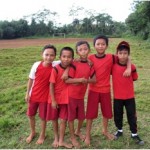
Kids barefoot on a toxic field in Indonesia
Recently, John Keith, Blacksmith’s globe-trotting expert, led an armchair tour of Asia’s toxic hotspots for a group in NYC. An environmental engineer, John has worked on numerous projects in 72 countries and counting, and he has plenty of stories to tell. Here is a brief itinerary of the tour for those who missed it. Look out for more lectures in Blacksmith’s Pollution Talks series.
1. Sumgayit and Absheron Peninsular, Azerbaijan
Sumgayit was a major Soviet industrial center with more than 40 factories manufacturing industrial and agricultural chemicals, and innumerable oil wells. About 20% of Soviet Era polluting factories are reportedly still operating. Even if all the polluting industries are dealt with, there remains a significant legacy cleanup challenge.
This is home to a former Soviet-era uranium plant. From 1946-1968, the plant produced and processed more than 10,000 metric tons of uranium ore — materials eventually used to create the Soviet Union’s first atomic bomb. What remains now are not atomic bombs, but 1.96 million cubic meters of radioactive mining waste that has contaminated the water. Blacksmith is currently working to filter water supplies for schools.
3. Ankleshwar, India
Reportedly the largest industrial estate in India, Ankleshwar dumps its waste into the Narmada River, contaminating the local source of fish. Air pollution from the many factories is also a major issue.
Leather tanning operations are a big source of contamination throughout Asia. Chromate salts are used in the tanning process, and chromium is the main toxic pollutant of concern. Ranipet is a hub of leather tanning in South India. Also in the area is an abandoned chromate salts factory, where there is an estimated 150,000 tons of solid waste accumulated over two decades of plant operation stacked in an open yard on the premises of the factory.
5. Vellore, India
Recycling of used lead acid batteries (ULAB) with poor environmental controls creates one of the world’s worst pollution problems. The activity is done globally, often by small operations with few, if any, controls. In Vellore, Blacksmith is working with a battery recycler who has shown a willingness to improve his practices, and after the improvements are made, Blacksmith will move to remediate a contaminated residential area and a primary school.
6. Marilao/Mecauacan River, Philippines
The Marilao, Meycauyan and Obando river system is home to hundreds of thousands of people and numerous industries, most of which pump their wastewater untreated into the river. The extensive aquaculture industry at the mouth of the river is a major source of fish for the people of Manila and testing has shown the fish to be contaminated with heavy metals.
Artisanal gold mining results in the release of about 1,000 tons of mercury per year, which constitutes about 30 percent of the world’s mercury emissions. It is estimated that there are between 10 and 15 million artisanal and small-scale gold miners worldwide, including 4.5 million women and 600,000 children. Mercury is boiled off to extract the gold – a process that often takes place in homes. Blacksmith has been working to introduce a simple retort to miners in Indonesia that can use to recapture most of the mercury used. Blacksmith is also working with partners to introduce the use of non-toxic borax instead of mercury to extract gold.
8. Cinangka, Indonesia
The improper disposal of waste from the recycling of used lead acid batteries has contaminated the land with toxic lead. A school with 500 children is located nearby. Children often play barefoot on a field, exposing them to lead poisoning. Blacksmith is working to excavate the lead waste and contaminated soil, and move the toxic material to a secure, lined landfill. The local authorities plan to build a soccer stadium over the site once it is cleaned.





